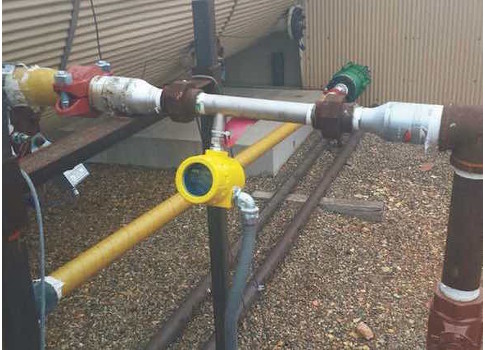Solar-powered thermal mass flowmeters operate in flare-gas monitoring system
How can new gas flowmeters operate at an oilfield without utility power service in the remote southern Bakken formation region of North Dakota? That was the challenge facing Legacy Reserves at remote sites at the Williston Basin, N.D.
 In an era of increasing environmental concern and regulation, the team at this isolated oilfield at the Williston Basin needed to upgrade its waste gas reporting capabilities for the North Dakota Industrial Commission (NDIC) and the U.S. Bureau of Land Management (BLM). The team realized that new state and federal regulations would require monthly testing and reporting, requiring more sophisticated flow measurement.
In an era of increasing environmental concern and regulation, the team at this isolated oilfield at the Williston Basin needed to upgrade its waste gas reporting capabilities for the North Dakota Industrial Commission (NDIC) and the U.S. Bureau of Land Management (BLM). The team realized that new state and federal regulations would require monthly testing and reporting, requiring more sophisticated flow measurement.
"We are now required by the NDIC to monitor waste gas resulting from each of our 14 production wells," said Bernie Schillo, production foreman at Legacy Reserves. "We wanted to add new flowmeters to each well for this purpose in advance of the deadline. The state has set new limits for gas emissions, and we must stay within those limits or cutback well production."
Challenge: no outlet, no power
Without utility power at the field’s location in the Golden Valley of North Dakota, Schillo’s team decided to explore powering the meters with solar energy. The 14 wells are laid out on one well pad connected to a 3-phase heater/treater tank that separates the crude oil into three process streams: oil, natural gas, and water. Waste gas from the separation process, which is unsuitable for commercial use, is sent to a tank with a flare unit and burned off as necessary.
Each of the 14 well heads would require two air/gas flowmeters to support the process. The variable and sometimes low flow volume at the wells meant that differential pressure technologies, such as orifice plates could not be used. The company also wanted to use existing gas lines as much as possible.
The team completed an assessment for the NDIC prior to starting the project to prove that production could continue while meeting environmental standards. Previous regulations required only one annual 24-hour test of the flare-gas monitoring system. Today, the more stringent monitoring requirements are driving the need for continuous flow measurement.
"We had to convince the state that it was more cost effective to install flowmeters on the wells than to install multiple new gas lines," Schillo said. "Our gas streams are on the low volume side and the other approach (news gas lines) just wasn’t practical."
The final answer: solar power
Schillo’s team contacted Mike Smith, Jasper Engineering, Williston, N.D, to help with the solar-powered flowmeter system. Smith agreed with the feasibility of the team’s decision to use solar energy to power the flowmeters, and asked the applications team at Fluid Components International (FCI) for a flowmeter capable of handling the variable low-flow wet-gas measurement with solar power generation.
 Jasper Engineering helped the site team design the new solar-powered system for the flowmeters and additional components. The system is comprised of two 50 W panels to provide 24-hour power, even during the cold snowy North Dakota winters. The team chose two large 12-V, 40-Amp/hr backup batteries housed in an enclosure (see Figure 1).
Jasper Engineering helped the site team design the new solar-powered system for the flowmeters and additional components. The system is comprised of two 50 W panels to provide 24-hour power, even during the cold snowy North Dakota winters. The team chose two large 12-V, 40-Amp/hr backup batteries housed in an enclosure (see Figure 1).
FCI recommended a flowmeter with constant current thermal dispersion sensing technology that accurately measures variable low-flow wet-mixed composition gases for the 14 wells (see Figure 2). The meter also features low-input power requirements compatible with the solar energy system.
The flowmeters are accurate to ±1% of reading over a broad flow range, with repeatability of ±0.5% of reading in this wet gas application. The meter’s flow sensor supports line sizes from 2- to 24-in. diameters. This meter’s thermal dispersion mass flow sensing element has no moving parts and no orifices to clog or foul for minimal maintenance in wet, dirty gas applications.
The design of the flow sensor places two protected platinum resistance temperature detector (RTD) temperature sensors in the process stream. One RTD is heated while the other senses the actual process temperature. The temperature difference between these sensors generates an analog output, which is proportional to the media cooling affect and compensates for changes in pressure and temperature to provide a direct mass-flow output without additional instrumentation.
It took the crew only 1.5 days to complete the installation after a short training presentation. The meters were installed at a 45-deg angle to avoid wet gas accumulation on the sensor head that could affect measurement accuracy.
Schillo said at the conclusion of the project, "What we’re seeing with the new meters is extremely positive. They’ve proven themselves already during our reviews with the NDIC and BLM staff. The meters are performing to specification and meet our requirements. We will consider using them on future projects."
Bernie Schillo, production foreman, Legacy Reserves, LP; Mike Smith, technical sales, Jasper Engineering; and Steve Cox, applications manager, Fluid Components International (FCI).
ONLINE extra
– See additional stories about thermal mass flowmeters linked below.
Do you have experience and expertise with the topics mentioned in this content? You should consider contributing to our CFE Media editorial team and getting the recognition you and your company deserve. Click here to start this process.


